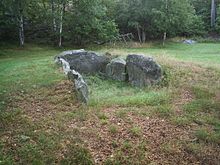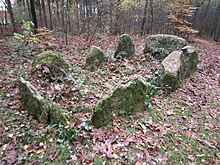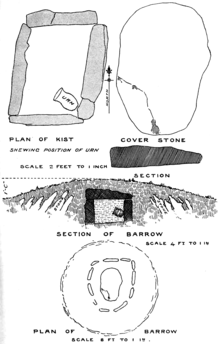Stone box

The stone box ( English stone cist; Danish sten-, grav- or hellkisten; Swedish hällkista; Cornish cistvaen or kistvaen; French coffre mégalithique ) is a Stone Age depot for skeletons or human bones. This form of storage can be found at different times in parts of Eurasia and the Orient as well as in South and East Asia. In European areas with megalithic architecture, stone boxes are often found parallel to other types of systems, but also before and / or after their construction. In Switzerland, from 4300 BC Chr. Occurring stone box type Chamblandes the oldest megalithic plants.
The monuments are an expression of the culture and ideology of Neolithic societies. Origin and function are considered to be the hallmarks of social development.
Stone boxes usually consist of flat, vertically placed stone slabs in a box-like, very rarely a polygonal shape. If they are underground or at ground level, they can ceiling plate of an out with (an rarely) Cairn , a Röse or Tumulus be covered. Only in exceptional cases (locally) is the floor made of stone slabs.
Typology
In principle, a stone box has no access (although there are those with a soul hole ). Although there are above-ground stone boxes that were sometimes in a hill that had since been eroded (Juelsberg), most of them were sunk into the ground (Filholm, Folehaven in Denmark). The north Jutland grave boxes with curb stones, access, threshold stones and spacious chamber, the capstone of which is sometimes even supported by stone posts, are reminiscent of temple buildings. As with the Urdolmen, the question of whether certain small boxes are megalithic or submegalithic in nature is controversial. In terms of material, Hans-Jürgen Beier describes box-like buildings with side access as "passage grave boxes".
Differentiation between stone boxes, grave boxes and ancient dolmen
In the necropolis of Brüssow -Wollschow, in the Uckermark , 14 Urdolmen (five have been preserved) and 28 stone boxes were found. In many cases a clear separation is impossible. The differences are in the degree of depression and in the material of the wall stones. In the case of Urdolmen, they consist of attachments, in the case of stone boxes, they consist of slabs. Whether this was relevant to the Neolithic people remains questionable. The basic plan of the Nordic grave boxes is, as with many dolmens, pear-shaped, trapezoidal or mostly square. A short, south-facing corridor with a threshold stone begins as an extension of the chamber .
The Swedish archaeologist Oscar Montelius (1843–1921) divided the Stone Age into a "dolmen, passage grave and stone crate" era. The stone box period corresponds to the end Neolithic (cup cultures). This classification has hardly survived.
- Stone boxes
Floor plan of the stone box near Vadstena (Sweden)
Stone boxes in the vicinity of the funnel cup cultures

In the north of Central Europe and Scandinavia , the stone box appears with the younger phase of the funnel beaker cultures (TBK) from around 3500 BC. At the end of the Stone Age, the following distinguishable boxes exist in this area and beyond:
- the "small boxes" in the Uckermark
- the grave boxes on the street of the megalithic culture in western Lower Saxony
- the grave boxes and boxes made with coarse drywall in North Jutland
- the megalithic stone boxes in Sweden
- the megalithic stone boxes under hills in Kujawia , Poland
- the smaller stone boxes made of block material are called "block boxes" or "chambers" (Wollschow 19 + 29) in central Germany. The transition to the stone boxes, the walls of which are made of more plate-like material, and to the ancient dolmen is fluid.
- the boxes of the successors of the TBK, stone box in the Uelzen city forest
- the block or plate boxes of the spherical amphora culture in northeastern Poland ( stone boxes in East Prussia )
- the end neolithic (or later) boxes of the boat ax culture in Sweden, the spherical amphora culture, the Bernburg culture , the beaker cultures and other cultures.
In the Hercynian area, own names such as gallery grave are common.
End Neolithic
End neolithic stone boxes can also be found under mounds of earth and stone. An example of this is the Bargloyer stone box with its capstone strewn with bowls . The stone box in Feldmark Rade , the stone box from Fehrenbruch and the stone box from Deinste are probably elements of the individual grave culture . In Saxony-Anhalt , the boxes from Langeneichstädt ( Bernburg culture ) and the unopened stone box from Esperstedt ( cord ceramist ) should be mentioned. Large (up to 14 m long) and small boxes from this period are particularly numerous in Sweden (Södra Härene in Västergötland, Fjällsökla / Frändefors in Dalsland ). They lie both in the ground and under mostly flat mounds of earth and stone of angular, oval or round shape. K. Ebbesen lists 17 stone boxes that are found as secondary fixtures in the burial mounds of megalithic systems of the TBK.
Bronze age
In Sweden the stone mounds, under which the now exclusively small stone boxes are to be found, are called Röse . The Röse from Kauparve on Gotland is an impressive construction . Here the boxes give up their rectangular shape at the end and are designed as ships just below the surface of the earth. A variant of the stone box is the grave box, which was built in Sweden from flat, worked panels and bears picture-stone-like decorations, which was in use until the Christian period (1200 AD). In Norway, a triangular stone chest with a corpse was found in Drakjihaugen near Steinkjer . On Orkney one was discovered in the Fresh Knove . Other Scottish stone boxes can be found at Beauly , on the Dunan Aula and in Holm (Inverness).
Another rare form that is often found in connection with stone boxes are the boulder burials called boulder graves . Some boulders also have cup-and-ring markings or bowls or bowl pits . Ultimately, corpse burns are also deposited in the now very small stone boxes (Smerup on Thyholm, Denmark).
The most famous stone box in Germany is the stone box from Anderlingen in the district of Rotenburg (Wümme) , on the southern end stone of which three human figures can be seen in the manner of Scandinavian rock carvings , which are unique in Germany. The chamber made of granite slabs was oriented northwest-southeast and has the clear dimensions of 2.0 meters by 0.7 meters. Only a few bone fragments have survived from the former body burial. Judging by the grave goods, a man was buried here in the older Bronze Age. The stone box from Anderlingen was moved and rebuilt in the Maschpark in Hanover .
In Norway, where most of the boxes are in the Østfold (Haldenvassdraget, Spydeberg), only about a dozen stone boxes are known.
Others
The seven stone boxes and the Stone Age settlement of Kaseküla (also Kasekla) are located in Läänemaa in Estonia about 0.5 km southwest of the center of the village. They were discovered in 1971 and in 1973 the northernmost stone box located in a stone circle was excavated.
Rock box tombs
- Several stone box graves, carved into the bedrock and originally covered by stone slabs, can be found in the Marshan necropolis near Tangier (Morocco). They were re-used in Roman times; Finds of Roman grave goods are exhibited in the Musée de la Kasbah .
- Early and high medieval stone box tombs are located in a rock towered over by the local church in Duruelo de la Sierra in the northwest of the Spanish province of Soria . Similar rock tombs can be found in the neighboring towns of Palacios de la Sierra and Quintanar de la Sierra to the west .
- Other graves of this type have been discovered near Los Navalucillos in the central Spanish province of Toledo .
- The medieval necropolis of Peciña necropolis has around 50 graves of this type.
See also
literature
- Hans-Jürgen Beier : The megalithic, submegalithic and pseudomegalithic buildings as well as the menhirs between the Baltic Sea and the Thuringian Forest (= contributions to the prehistory and early history of Central Europe. Volume 1, ZDB -ID 916540-x ). Beier & Beran, Wilkau-Hasslau 1991, (at the same time: Halle-Wittenberg, University, habilitation paper, 1991: The megalithic, submegalithic and pseudomegalithic buildings as well as the menhirs in the five new East German federal states (formerly GDR), an inventory. ).
- OGS Crawford: Stone Cists. In: Antiquity. Volume 2, 1928, pp. 418-422.
- Ewald Schuldt : The necropolis of Wollschow, Pasewalk district, and the problem of the Neolithic stone boxes in Mecklenburg. In: Ground monument maintenance in Mecklenburg. Yearbook. 1974 (1975), ISSN 0067-9461 , pp. 77-144.
- Lene Melheim: Fra light box to åsrøys - fra åsrøys to light box? Om å putte ting i boks. 2006.
Web links
- Fascination archeology
- Search for Steinkiste in the catalog of the German National Library
- Search for stone box in the German Digital Library
- Search for Steinkiste in the SPK digital portal of the Prussian Cultural Heritage Foundation
Individual evidence
- ^ Johannes Müller : Neolithic Monuments and Neolithic Societies. In: Varia neolithica. Volume 6: Neolithic Monuments and Neolithic Societies. Contributions from the meeting of the Neolithic Working Group during the annual meeting of the North-West German Association for Ancient Research in Schleswig, 9. – 10. October 2007 (= contributions to the prehistory and early history of Central Europe. Volume 56). Beier & Beran, Langenweissbach 2009, ISBN 978-3-941171-28-2 , pp. 7–16, here p. 15.
- ↑ List of literature in: HJ Beier: The megalithic, submegalithic and pseudomegalithic buildings as well as the menhirs between the Baltic Sea and the Thuringian Forest. 1991, separate census.
- ↑ Ewald Schuldt: The necropolis of Wollschow, Pasewalk district, and the problem of the Neolithic stone boxes in Mecklenburg. In: Ground monument maintenance in Mecklenburg. Yearbook. 1974, 1975, pp. 77-144.










